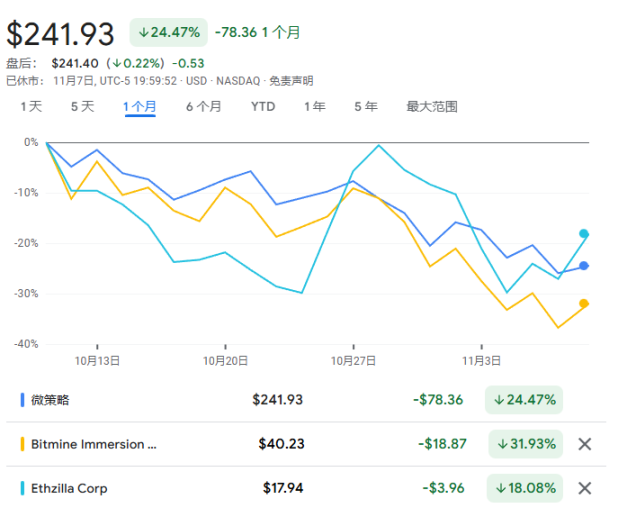The crypto market suffers consecutive crashes, and the "digital asset treasury company" that "leveraged cryptocurrencies" has collapsed.
Over the past month, MicroStrategy's stock price dropped by 25%, BitMine Immersion fell by more than 30%, while bitcoin declined by 15% during the same period.
Over the past month, MicroStrategy's stock price has fallen by 25%, BitMine Immersion has dropped more than 30%, while bitcoin's decline over the same period was 15%.
Written by: Zhao Ying
Source: Wallstreetcn
A cryptocurrency sell-off that began last October is now engulfing Wall Street’s hottest investment strategy of the year. “Digital asset treasury companies” that buy bitcoin, ethereum, and other cryptocurrencies by borrowing or raising funds were once seen by investors as an excellent way to leverage crypto exposure. Now, their stock prices have fallen far more than the tokens they hold.
This model was pioneered by Michael Saylor in 2020, transforming a small software company called MicroStrategy into a bitcoin whale. The company’s market capitalization peaked at about $128 billion last July, but has since shrunk to around $70 billion. Over the past month, MicroStrategy's stock price has dropped 25%, while bitcoin's decline over the same period was 15%.
This round of sharp declines has affected several heavyweight investors, including well-known venture capitalist Peter Thiel. BitMine Immersion Technologies, an ethereum treasury company backed by Thiel, has fallen more than 30% in the past month, while another Thiel-backed company, ETHZilla, which pivoted from biotech, dropped 23% over the same period.

The total market capitalization of cryptocurrencies has plunged about 20% from the all-time high of nearly $4.4 trillion reached on October 6, almost erasing all gains from the first ten months of this year. Year-to-date gains now stand at just 2.5%, down about 18% from the record high of $120,000 set on October 6.
The Logic Behind Treasury Company Premiums Is Being Questioned
The core issue with digital asset treasury companies is that investors are effectively paying a premium far above the net asset value for companies holding cryptocurrencies. Brent Donnelly, president of Spectra Markets, bluntly stated: “The whole concept makes no sense to me. You’re just paying $2 for a $1 bill. Eventually, these premiums will be compressed.”
This skepticism is not unfounded. Well-known Wall Street short seller Jim Chanos has previously shorted MicroStrategy while buying bitcoin, believing there is no reason for investors to pay a premium for Saylor’s company.
Last Friday, he told clients it was time to close out this trade. In an interview on Sunday, he said that although treasury company stocks are still overvalued, the premium is no longer extreme, and “the logic of this trade has basically played out.”
When digital asset treasury companies first emerged, they provided a channel for institutional investors who previously found it difficult to invest directly in cryptocurrencies. However, cryptocurrency exchange-traded funds launched over the past two years now offer the same solution, weakening the unique value proposition of treasury companies.
Leverage Effect Amplifies Downside Risk
“Digital asset treasury companies are essentially leveraged crypto assets, so when cryptocurrencies fall, they fall even more,” said Matthew Tuttle. The MSTU ETF he manages aims to provide twice the return of MicroStrategy, but has plunged 50% in the past month.
This leverage effect is vividly reflected in many treasury companies. Tuttle also emphasized, “Bitcoin has proven it’s not going away, and buying the dip will be rewarded.”
Matt Cole, CEO of bitcoin treasury company Strive, said that earlier this year, the company’s average purchase price for bitcoin was more than 10% higher than current levels. Strive’s stock price has fallen 28% in the past month. Cole noted that many treasury companies are “in trouble” because companies facing losses find it difficult to issue new shares to buy more crypto, which could put pressure on cryptocurrency prices and raise questions about these companies’ business models.
However, Cole said that Strive, having recently raised funds through preferred stock rather than debt, is well-positioned to “weather the volatility.”
Believers Are Still Holding On
Despite the setbacks, some investors are still increasing their positions. Cole Grinde, a 29-year-old investor from Seattle, bought about $100,000 worth of BitMine shares at around $45 each earlier this year when the company began accumulating ethereum. He is currently down about $10,000. But the beverage industry salesman says he is adding to his position and is selling BitMine options to help offset his losses.
Grinde attributes his confidence in the company to the growing popularity of the ethereum blockchain and the influence of Tom Lee. Lee, who worked at JPMorgan for 15 years, is now a managing partner at Fundstrat Global Advisors and a frequent guest on business TV shows. “I think his network and charisma helped the stock price soar after he took over,” Grinde said.
Saylor himself has maintained his usual optimism, declaring on social media that bitcoin is currently “on sale.”
Disclaimer: The content of this article solely reflects the author's opinion and does not represent the platform in any capacity. This article is not intended to serve as a reference for making investment decisions.
You may also like
Ethereum News Update: Realizing PoS Capabilities: Authorities Approve Staking for ETPs
- U.S. Treasury and IRS issued guidance allowing crypto ETPs to stake Ethereum and Solana without regulatory risks, advancing PoS blockchain adoption. - Framework requires ETPs to hold single PoS assets, use qualified custodians, and maintain liquidity for redemptions during staking. - Staking yields (1.8-8% annually) now accessible to retail investors via compliant ETPs, with rewards taxed as income at receipt. - Industry leaders called the move transformative, removing legal barriers for fund sponsors wh

SI-BONE's innovative approach fuels both EBITDA gains and increased revenue
- SI-BONE reported Q3 2025 adjusted EBITDA of $2. 3M and raised full-year revenue guidance to $198M–$200M. - Gross margin expanded to 79.8%, while operating losses narrowed by 29.5% despite 11.9% higher operating expenses. - Cash reserves remained stable at $145.7M, with CEO citing growth from minimally invasive solutions and global expansion. - Analysts highlight innovation and expanded indications as key drivers for future orthopedic market share gains.

Ethereum Updates: Treasury's Staking Safe Harbor Redefines Institutional Approaches to Crypto
- U.S. Treasury and IRS issued 2025 guidance allowing crypto ETFs to stake assets, accelerating adoption of proof-of-stake blockchains like Ethereum and Solana . - Solana ETFs (BSOL, GSOL) attracted $659M in inflows, contrasting with $2.7B outflows from Bitcoin and Ethereum funds amid bearish price trends. - Institutional staking yields ($100M+ annualized for Ethereum) and ETF inflows signal maturing crypto markets, with technical indicators hinting at potential Q4 recovery. - Regulatory clarity on staking

Ethereum News Update: Regulatory Green Light for Staking—US Approves Crypto ETFs Offering 7% Returns
- U.S. Treasury and IRS issued guidance enabling crypto ETFs/trusts to stake assets and distribute rewards, resolving regulatory uncertainties. - The "safe harbor" framework requires single-asset PoS custody, liquidity protocols, and prohibits non-staking activities to avoid securities law violations. - Staking rewards are now taxable income for trusts, boosting yields up to 7% and accelerating institutional adoption of Ethereum/Solana networks. - Industry experts call it a "game changer," removing legal b

